14
When the heater is ON:
The flame should be blue with straight yellow tops. If excessive yellow flame is detected,
turn the heater off and consult “Troubleshooting” on page 14
Re-lighting:
Note: For your safety, control knob cannot be turned OFF without first depressing con-
trol knob in PILOT position and then rotating it to OFF.
1. Turn control knob to OFF
2. Wait at least 5 minutes to let gas dissipate before attempting to relight pilot
3. Repeat the “lighting” steps on prior page.
Shut Down:
1. Turn the control knob clockwise to PILOT. (Normally burner will make a slight pop-
ping sound when extinguished.) Burner will extinguish but PILOT will remain ON.
2. To extinguish PILOT, depress control knob and continue to turn it clockwise to OFF.
3. Turn cylinder valve clockwise to OFF and disconnect regulator when heater is not in
use. Note: After use, some discoloration of the emitter screen is normal.
Operation Checklist
For a safe and pleasurable experience, perform this check before each use.
Before Operating
1. I am familiar with entire owner’s manual and understand all precautions noted.
2. All components are properly assembled, intact, and operable.
3. No alterations have been made.
4. All gas connections are secure and do not leak.
5. Wind velocity is below 10 mph
6. Unit will operate at reduced efficiency below 40°F
7. Heater is outdoors (outside any enclosure).
8. There is adequate fresh air ventilation.
9. Heater is away from gasoline or other flammable liquids or vapors
10. Heater is away from windows, air intake openings, sprinklers, and other water sources.
11. Heater is at least 24 in. on top and at least 36 in. on sides from combustible materials.
12. Heater is on a hard and level surface.
13. There are no signs of spider or insect nests.
14. All burner passages are clear.
15. All air circulation passages are clear.
16. Children and adults should be alerted to the hazards of high surface temperatures and
should stay away to avoid burns or clothing ignition.
17. Young children should be carefully supervised when they are in the area of the heater.
18. Clothing or other protective material should not be hung from the heater or placed on/
near the heater
19. Any guard or other protective device removed for servicing the heater must be replaced
prior to operating the heater.
20. Installation and repair should be done by a qualified service person. The heater should be
inspected before use and at least annually by a qualified service person.
21. More frequent cleaning may be required as necessary. It is imperative that the control
compartment, burner, and circulating air passageways of the heater be kept clean.
7
IMPORTANT INSTRUCTIONS
READ ALL INSTRUCTIONS BEFORE USING THE HEATER.
WARNING
(1) Do not store or use gasoline or other flammable vapors and liquids in the vicinity of this or any
other appliance to protect an LP-cylinder not connected for use.
(2) Improper installation, adjustment, alteration, service, or maintenance can cause property dam-
age, injury, or death. Read the installation, operation, and maintenance instructions thoroughly
before installing or servicing this equipment.
(3) We cannot foresee every use which can be made of our heaters. Check with your local fire
safety authority if you have questions about heater use. Other standards govern the use of fuel
gases and heat producing products for specific uses. Your local authorities can advise you
about these. If no local codes exist, follow National Fuel Gas Code, if ANS Z223. 1. In Can-
ada, installation must conform to local codes. If no local codes exist, follow the current Na-
tional standards of CANADA CAN/CGA-B 149.2
(4) Improper installation, adjustment, alteration, service, or maintenance can cause property dam-
age, injury, or death. Read the installation, operation, and maintenance instructions thoroughly.
(5) Burn Hazard: never leave heater unattended when hot or in use; keep out of reach of children
(6) Anything stored under the heater will be subjected to radiant heat and possibly damaged.
(7) Items under the heater will be subjected to radiant heat and could be seriously damaged.
(8) SERVICE SAFETY: Keep all connections and fittings clean. Make sure propane cylinder
valve outlet is clean. Never use a flame. Use as a heating appliance only. Never alter in any
way or use with any device.
(9) This product is fueled by propane gas. Propane gas is invisible, odorless, and flammable. An
odorant is normally added to help detect leaks and can be described as a “rotten egg” smell.
The odorant can fade over time so leaking gas is not always detectable by smell alone.
(10) Propane gas is heavier than air and leaking propane will sink to the lowest level possible. It can
ignite by ignition sources including matches, lighters, sparks, or open flames of any kind many
feet away from the original leak. Use only propane gas set up for vapor withdrawal.
(11) Store or use propane gas in compliance with local ordinances and codes or with ANS/NFPA
58. Turn off propane when not in use.
(12) Alert children and adults to the hazards of high surface temperatures. Stay away from these
surfaces to avoid burning skin or igniting clothing.
(13) Carefully supervise young children when in the vicinity of the heater. Do not hang clothing or
any other flammable materials from the heater or place on or near the heater.
(14) Replace any guard or protective device removed for servicing the appliance before using
(15) Installation and repair should be done by a qualified service person. The heater should be in-
spected before use and annually by a qualified service person. More frequent cleaning may be
required as necessary. It is imperative that the control compartment, burners, and circulating
air passageway of the appliance be kept clean.
(16) Heater will be hot after use. Handle with extreme care and do NOT touch or move heater or
reflector for at least 45 minutes after use.
(17) Be careful when attempting to manually ignite this heater. Holding in the control knob for
more than 10 seconds before igniting the gas will cause a ball of flame upon ignition.










 1
1
 2
2
 3
3
 4
4
 5
5
 6
6
 7
7
 8
8
 9
9
 10
10
Hanover HAN0202HB User manual
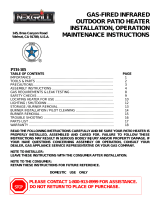 Nexgrill PTH105-3G-OBK Owner's manual
Nexgrill PTH105-3G-OBK Owner's manual
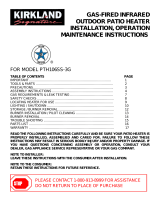 Nexgrill PTH106-SS-3G Owner's manual
Nexgrill PTH106-SS-3G Owner's manual
Hanover HAN103BR-CV User manual
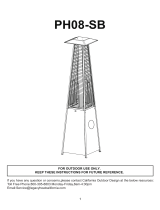 Patio Post GHFIRE02 Operating instructions
Patio Post GHFIRE02 Operating instructions
AZ Patio Heaters NG-GT-BRZ User manual
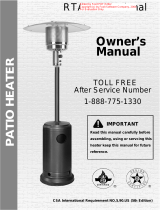 Rta International JDS01BST Owner's manual
Rta International JDS01BST Owner's manual
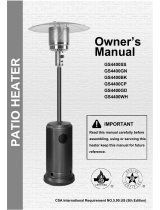 Garden Sun GS4400GD Owner's manual
Garden Sun GS4400GD Owner's manual
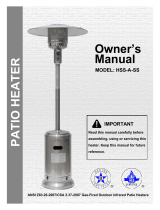 Changzhou Gardensun Furnace HSS-A-SS Owner's manual
Changzhou Gardensun Furnace HSS-A-SS Owner's manual
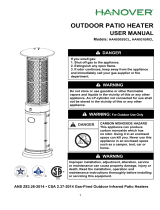 Lava Heat MINI LAVA Owner's manual
Lava Heat MINI LAVA Owner's manual


















